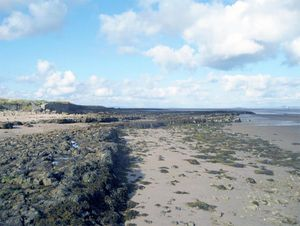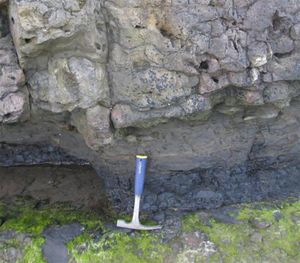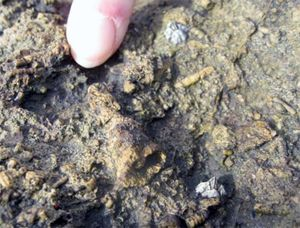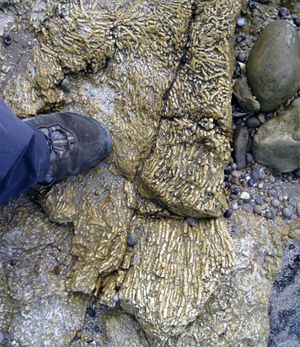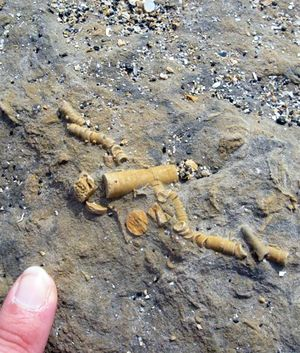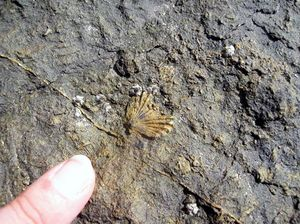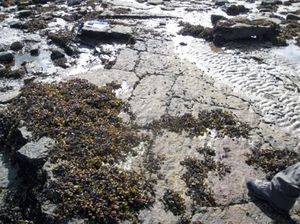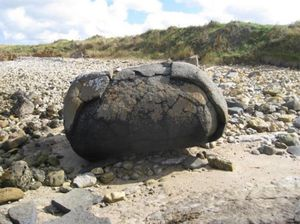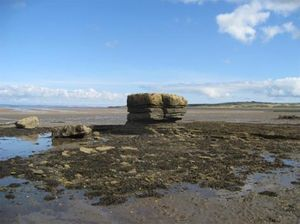Background
The Kilspindie Shore site encompasses the western part of Aberlady Bay and the northern area of Gosford Bay. The site is located to the north-west of the town of Aberlady. The 2.2 km section contains limestones of the Clackmannan Group: the Hurlet, the Blackhall and the Inchinnan, as well as the Blackbyre Limestone belonging to the Strathclyde Group. The Gosford Bay Sill which is exposed at the western end of the site is younger in age and is composed of analcime gabbro (dolerite). These exposures are best seen at low tide.
Sedimentary Rocks
The oldest rocks exposed on the Kilspindie Shore site belong to the Strathclyde Group, and are found to the west of the site. These strata comprise siliciclastic rocks of the Aberlady Formation; interbedded pale cream sandstone, siltstones and mudstones with subordinate coal, seatrock, limestones and ironstone. These strata were deposited in a variable environment characterised by fluvial deposition and development of shallow marine conditions. Exposed within the sequences is the Blackbyre Limestone, a pale grey crinoidal argillaceous limestone indicative of a transition to a deeper marine sedimentary environment.
The majority of the sedimentary rocks exposed on the shore at Kilspindie form the lower part of Lower Limestone Formation (Clackmannan Group). The Lower Limestone Formation comprises a cyclic sequence of calcareous mudstones, limestones, sandstones and siltstones containing thin coal seams and some seatearths. The Hurlet Limestone, seen on both the eastern and western part of this shore section marks the boundary between the Clackmannan Group and the underlying Strathclyde Group. The Hurlet Limestone forms a prominent 1–5 m bed across the site (ELC_14 P1), with a rubbly, brown weathered top surface. In the eastern part of its exposure, just before Craigielaw Point, the Hurlet Limestone is underlain by a shale bed sitting above a 20 cm thick band of coal (ELC_14 P2). The limestones of the Lower Limestone Formation are fossiliferous, containing crinoids, corals, and brachiopods (ELC_14 P3, P4). At the far west of the site is an exposure of the massive Blackhall Limestone, stratigraphically younger than the Hurlet Limestone. The Blackhall Limestone is up to 8 m thick, massive, and contains crinoid fragments and productid brachiopods (ELC_14 P5, P6). The limestones contain mineral lined vugs of orange/brown calcite ‘teeth’, representing reprecipitated carbonates from dissolution of the limestone.
The cyclic sequences between the limestones are composed of sandstone, siltstone, mudstone and subordinate limestone. The sandstone is quartz-rich, fine to medium grained, with organic patches throughout. There is an indication of bioturbation and rippled features on bedding planes (ELC_14 P7). The siltstones are black/grey, occasionally fossiliferous, very finely bedded and are interbedded with yellowish/brown limestone. The sandstone and interbedded shale is well exposed at a low cliff below a red-tiled hut owned by the Kilspindie Golf Club in the midpoint of the site.
Volcanic Rocks
The Lower Limestone Formation is intruded by the Gosford Bay Sill, an olivine-analcime-gabbro. Exposure of the sill is accessible at high tide, adjacent to the concrete tank blockades sit on the shore (ELC_14 P8).
Quaternary Deposits and Landforms
The shore of the section is littered with glacial erratics of igneous origin, with mafic (dolerite or gabbroic) erratics displaying onion skin weathering (ELC_14 P9). An outlier of sandstone resting on shale forms a sea stack to the north of the site, known as the King’s Kist (ELC_14 P10). Intertidal marine beach deposits form expanses of sand flat that are included within the adjacent Aberlady Bay geomorphological site (ELC_30).
Access and Additional Information
There is good access along the coast line at high tide for most of the site, with access along the side of Kilspindie and Cragielaw golf club possible where the tide is too high. The site is best visited at low tide when one can walk on the shore and see most of the exposures. Parking is advised in Aberlady itself as the car parks near the section belong to Kilspindie Golf Club. The East Lothian Ranger service do not encourage large numbers of visitors along this section of coast due to the diverse bird life along this stretch of shore.
|

